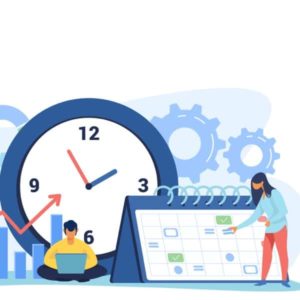
22 Dec What is a time clock
What is a time clock?
A time clock system is a device that is used to record the time that employees start and end their work shifts. It is typically used in conjunction with a time and attendance software that allows an employer to track the hours worked by each employee and to calculate their pay. Time clock systems can be mechanical, electronic, or web-based and can be used to record attendance for employees who work on-site or remotely.
Mechanical time clocks are the most basic type of time clock system. They typically consist of a clock face and a time card that is punched by the employee when they start and end their shift. The time card then shows the employee’s start and end times, and the employer can use this information to calculate the employee’s pay.
Electronic time clocks are similar to mechanical time clocks, but they use electronic technology to record and store the start and end times of an employee’s shift. These systems may be connected to a computer network, allowing the employer to access and manage the time and attendance data remotely.
Web-based time clock systems are accessed through a web browser and are typically used by employees who work remotely or at multiple locations. These systems allow employees to clock in and out using a computer or mobile device, and the attendance data is automatically transmitted to the employer.
In general, time clock systems are used to accurately track the hours that employees work and to ensure that they are paid for all of the time that they are on the clock. They can also be used to help manage employee scheduling and attendance and to monitor compliance with labor laws and company policies.
Types of time clocks.
There are several types of time clocks that are used to track employee attendance and hours worked. These include:
Mechanical time clocks:
These are the most basic type of time clock, and they consist of a clock face and a time card that is punched by the employee when they start and end their shift. The time card then shows the employee’s start and end times, and the employer can use this information to calculate the employee’s pay.
Electronic time clocks:
These use electronic technology to record and store the start and end times of an employee’s shift. These systems may be connected to a computer network, allowing the employer to access and manage the time and attendance data remotely.
Biometric time clocks:
These use biometric technology, such as fingerprint scanners or facial recognition, to identify employees when they clock in and out. This type of time clock is often used to prevent time fraud, as it ensures that only the employee whose biometric data is registered in the system can clock in and out.
Web-based time clocks:
These are accessed through a web browser and are typically used by employees who work remotely or at multiple locations. These systems allow employees to clock in and out using a computer or mobile device, and the attendance data is automatically transmitted to the employer. Eg. ClockIt
Mobile time clocks:
These are time clocks that can be accessed using a smartphone or other mobile device. These systems are often used by employees who work in the field or at multiple locations, as they allow employees to clock in and out from any location with an internet connection.
Hybrid time clocks:
These are time clocks that combine features of multiple types of time clocks, such as electronic and biometric technology. These systems may be used to provide a greater level of security and accuracy in tracking employee attendance.
Benefits of using a time clock app
There are several benefits to using a time clock system to track employee attendance and hours worked:
Accurate tracking of hours worked:
A time clock system allows an employer to accurately track the hours that employees work, which can help ensure that they are paid for all of the time that they are on the clock. This can also help to prevent disputes over pay or overtime.
Improved payroll accuracy:
By accurately tracking employee hours, a time clock system can help to improve payroll accuracy and reduce the risk of errors or omissions when calculating pay.
Enhanced scheduling:
A time clock system can help an employer to more effectively manage employee schedules and ensure that there is sufficient staffing to meet the demands of the business.
Compliance with labor laws:
A time clock system can help an employer to ensure compliance with labor laws and regulations related to tracking employee hours and pay.
Increased productivity:
By accurately tracking employee attendance and hours worked, a time clock system can help to increase productivity and efficiency within an organization.
Reduced time fraud:
A time clock system can help to reduce time fraud, such as employees clocking in for each other or claiming to have worked more hours than they actually did. This can help to save the employer money and improve morale among honest employees.




